Permeability Characteristics and Mechanism of Silicone-Hydrophobic-Powder-Modified Compacted Loess
Abstract
:1. Introduction
2. Materials and Methods
2.1. Materials
2.2. Methods
2.2.1. Flexible Wall Seepage Test
2.2.2. Water Drop Infiltration Test
2.2.3. Water Evaporation Capacity Test of Loess
2.2.4. Nuclear Magnetic Resonance Test
2.2.5. Scanning Electron Microscopy
3. Results
3.1. Analysis of Permeability Characteristics of Improved Loess with Different Dry Densities
3.2. Analysis of Permeability Characteristics of Improved Loess with Different Organic Silicone Contents
3.3. Analysis of Water Inflow Capacity
3.4. Analysis of Water Vapor Evaporation Capacity
3.5. Analysis of Nuclear Magnetic Resonance Results of Modified Loess
3.6. Analysis of Scanning Electron Microscopy Results of Modified Loess
4. Discussion
5. Conclusions
- (1)
- The addition of 1–3% silicone hydrophobic material to remolded loess results in a significant anti-permeability effect. The permeability coefficient of modified loess decreases exponentially with the increase in the silicone content. When the remolded loess is compacted to a low dry density (1.35 g/cm3), the permeability coefficient decreases by approximately 87% after the addition of 3% SHP. When the dry density increases to 1.50 and 1.65 g/cm3, the permeability coefficient of compacted loess with 3% content decreases to approximately 5% of that without hydrophobic material.
- (2)
- With the addition of SHP, the large pores in part of the loess are converted to small and medium pores without cementation filling. The silicone particles are adsorbed on the surface of the loess skeleton to form a hydrophobic film. This phenomenon enhances the water repellence of the loess particles and generates a non-closed hydrophobic structure, thereby effectively reducing the saturated permeability without significantly affecting the water evaporation capacity.
- (3)
- After the silicone hydrophobic material is incorporated into the loess, several silicone particles adhere to the surface of the loess skeleton, thereby forming a hydrophobic film and improving the water repellence of the loess particles. Consequently, the surface of the silicone-modified loess is transformed from hydrophilic to strongly water repellent.
- (4)
- By optimizing the additional contents of silicone hydrophobic materials into remolded loess for compaction and filling, the permeability coefficient of compacted loess can be effectively reduced without increasing the degree of compaction, while the ability of water vapor evaporation inside the loess can be guaranteed. The findings can help promote post-construction water field control and anti-seepage treatment of weak parts in loess filling projects.
Author Contributions
Funding
Institutional Review Board Statement
Informed Consent Statement
Data Availability Statement
Conflicts of Interest
References
- Duan, X.; Dong, Q.; Men, Y.M.; Chang, Y.; Ye, W. Study on the change of groundwater and soil moisture content after high fill construction in loess gully. Chin. J. Geotech. Eng. 2018, 40, 1753–1758. [Google Scholar]
- Yin, X.X.; Chen, L.W.; He, J.D.; Feng, X.Q.; Zeng, W. Characteristics of groundwater flow field after land creation engineering in the hilly and gully area of the Loess Plateau. Arab. J. Geosci. 2016, 9, 646. [Google Scholar] [CrossRef]
- Huo, C.C. Research on the Influence Of groundwater Level Rise on the Stability of Loess High Fill Slope. Master’s Thesis, Chang’an University, Xi’an, China, 2016. [Google Scholar]
- Guo, J.F.; Chen, Z.H.; Guo, N. Coupling analysis of deformation and water migration of high fill project in Yan‘an New Area. J. Chin. J. Geotech. Eng. 2021, 43, 143–148. [Google Scholar]
- Zhu, C.H.; Li, N. Study on the effect of rainfall on the humidification of gully loess high fill foundation. Chin. J. Geotech. Eng. 2020, 42, 845–854. [Google Scholar]
- Dong, Q.; Duan, X.; Li, Y.; Chang, Y. Subsidence deformation law of high embankment after 12 months in loess ravine. Coal Geol. Explor. 2016, 44, 89–95. [Google Scholar]
- Luo, T.; Chen, D.; Yao, Y.P.; Liu, L.; Hu, S.X. Effect of loading path on one-dimensional creep characteristics of remolded loess. J. Chin. J. Geotech. Eng. 2018, 40, 1294–1299. [Google Scholar]
- He, J.F. Study on the Law of Wetting Deformation and Settlement of High Fill Foundation by Rainfall and Groundwater Level Rise. Master’s Thesis, Xi’an University of Technology, Xi’an, China, 2021. [Google Scholar]
- He, X.; Ma, G.L.; Wang, Y.; Zhao, C.; Liu, H.L.; Chu, J.; Xiao, Y. Visualization of microbial reinforcement based on microfluidic chip technology. Chin. J. Geotech. Eng. 2020, 42, 1005–1012. [Google Scholar]
- Zhang, P.Y.; Ma, X.N.; Li, S.Z.; Wang, X. Evaluation of long-term dynamic stability of cement-improved loess subgrade for high-speed railway. Vib. Impact 2019, 38, 80–87. [Google Scholar]
- Zhang, Y.C.; Yao, Y.G.; Zhou, H. Experimental study on shear strength and permeability of long-age improved loess. Geotech. Mech. 2017, 38, 170–176. [Google Scholar]
- Liu, Z.; Wang, H.; Cao, S.; Sun, Z.; Wang, N.; Zhang, Z.; Rong, Y. Variation Characteristics of Particle Surface Electrochemical Properties during the Improvement of Reclaimed Soil from Hollow Village in Loess Area. Sustainability 2022, 14, 11527. [Google Scholar] [CrossRef]
- Hong, B.; Li, X.A.; Wang, L.; Li, L.C. Application of capillary seepage model in loess permeability. J. Eng. Geol. 2018, 26, 1250–1256. [Google Scholar]
- Hu, Z.Q.; Liang, Z.C.; Guo, J.; Feng, Z.; Wang, K.; Zhe, H.C. Prediction of seepage coefficient of unsaturated lime-improved loess. J. Chin. J. Geotech. Eng. 2020, 42, 26–31. [Google Scholar]
- Zheng, L. Study on Permeability Characteristics of Improved Loess. Master’s Thesis, Chang’an University, Xi’an, China, 2021. [Google Scholar]
- Gao, Z.N. Study on the Anti-Liquefaction Strength and Characteristics of Saturated Loess Improved by Fly Ash. Master’s Thesis, Lanzhou University, Lanzhou, China, 2018. [Google Scholar]
- Zhang, X.J.; Liu, P.; Yang, X.Q.; Wang, Y. Study on the relationship between permeability and pore structure of lime-improved loess. J. Guangdong Univ. Technol. 2021, 38, 97–103. [Google Scholar]
- Du, W.F.; Zheng, J.G.; Liu, Z.H.; Zhang, J.W.; Yu, Y.T. Settlement law of loess high fill foundation and influence of exhaust conditions. Geotech. Mech. 2019, 40, 325–331. [Google Scholar]
- Alireza, T.; Nima, L.; Christopher, L.M.; Kalehiwot, N.M. Laboratory investigation and field evaluation of loess improvement using nanoclay–A sustainable material for construction. Constr. Build. Mater. 2018, 158, 454–463. [Google Scholar]
- Navid, G.; Asskar, J.C.; Nader, R.; Seiyed, E. Ghasemi Geotechnical properties of the soils modified with nanomaterials: A comprehensive review. Arch. Civ. Mech. Eng. 2017, 17, 639–650. [Google Scholar]
- Nima, L.; Amin, E.; Aminaton, M.; Christopher, L.M. Tropical residual soil stabilization: A powder form material for increasing soil strength. Constr. Build. Mater. 2017, 147, 827–836. [Google Scholar]
- Hu, S.J. Study on Mechanical Properties of Loess Improved by Nano-Silica. Master’s Thesis, Lanzhou University, Lanzhou, China, 2021. [Google Scholar]
- Hu, Q.L.; Hou, S.P.; Ye, C.W.; Ding, X.; Wang, Y.S. Experimental study on impermeability of PAM-silicone modified cement soil. Sci. Technol. Eng. 2017, 17, 242–248. [Google Scholar]
- Peng, Y.; Zhang, H.Y.; Lin, C.B.; Wang, X.W.; Yang, L. Engineering properties and modification mechanism of loess improved by anti-dredging agent. J. Rock Mech. Eng. 2017, 36, 762–772. [Google Scholar]
- Bao, J.W.; Hu, W.W.; Zhang, P.; Li, Z.; Lei, F.H.; Zhao, T.J. Effect of silicone water repellent on strength and capillary water absorption of concrete. Silic. J. 2020, 48, 1644–1652. [Google Scholar]
- He, Y.; Zhang, X.; Zhang, Y.J.; Xia, X.D. Mechanism and performance of silicone microcapsule powder waterproofing agent. J. Build. Mater. 2015, 18, 433–437. [Google Scholar]
- Zhang, L.; Gao, R.X.; Rong, H.; Gao, L.X.; Zhang, Y. Effect and mechanism of permeable silicone coating method on protective performance of mortar. J. Build. Mater. 2019, 22, 523–529+537. [Google Scholar]
- Wang, H.L.; Li, Y.Z.; Rong, H.; Gao, L.X.; Zhang, Y.P. Effect of silicone protective agent on protective properties of aluminate cement mortar. J. Build. Mater. 2019, 22, 516–522. [Google Scholar]
- Xu, Y.Q. Experimental Study on Application of Organic Silicon to Rainwater Harvesting in Highway Central Green Belt. Master’s Thesis, Beijing Forestry University, Beijing, China, 2012. [Google Scholar]
- Zhao, S.J.; Li, Y.H.; Su, J.; Guo, Y.H. Study on the engineering characteristics of organic silicon reinforcement on loess slope. In Proceedings of the Oil and Natural Gas Exploration Technology Center Station 22nd Technical Exchange Conference, Langfang, China, October 2016; pp. 110–116. [Google Scholar]
- Choi, Y.; Choo, H.; Yun, T. Engineering Characteristics of Chemically Treated Water-Repellent Kaolin. Materials 2016, 9, 978. [Google Scholar] [CrossRef]
- Haquie, A.; Hart, M.L. Inducing Hydrophobicity to Improve Long Term Engineering Performance of Kaolinite Clay. In Proceedings of the International Congress on Environmental Geotechnis, Hangzhou, China, 28 October–1 November 2018; Springer: Singapore, 2018. [Google Scholar]
- Zhang, H.Y.; Wang, Z.M.; Zhu, J.H.; Zhou, G.P. Study on permeability and anisotropy of mixed buffer material block. Geotech. Mech. 2022, 43, 573–581+601. [Google Scholar]
- Nanjing Hydraulic Research Institute. SL237-1999Specification of Soil Tests; China Water Powder Press: Beijing, China, 1999. [Google Scholar]
- Bisdom, E.B.A.; Dekker, L.W.; Schoute, J.T. Water repellency of sieve fractions from sandy soils and relationships with organic material and soil structure. Geoderma 1993, 56, 105–118. [Google Scholar] [CrossRef]
- Wu, Y.T.; Ye, W.J.; Yang, G.S.; Duan, Z. Experimental study on microscopic pore and macroscopic deformation characteristics of soil considering stress path. J. Rock Mech. Eng. 2019, 38, 2311–2320. [Google Scholar]
- Ye, W.J.; Qiang, Y.H.; Jing, H.J.; Zou, Y. Experimental study on freezing-thawing cycles of loess paleosol with different water contents based on nuclear magnetic resonance. J. Eng. Geol. 2022, 30, 144–153. [Google Scholar]
- Zhao, W.H. Study on the Law of Water Migration and Settlement at the Interface of Loess Filling Area under Rainfall. Ph.D. Thesis, Northwest A & F University, Xianyang, China, 2022. [Google Scholar]

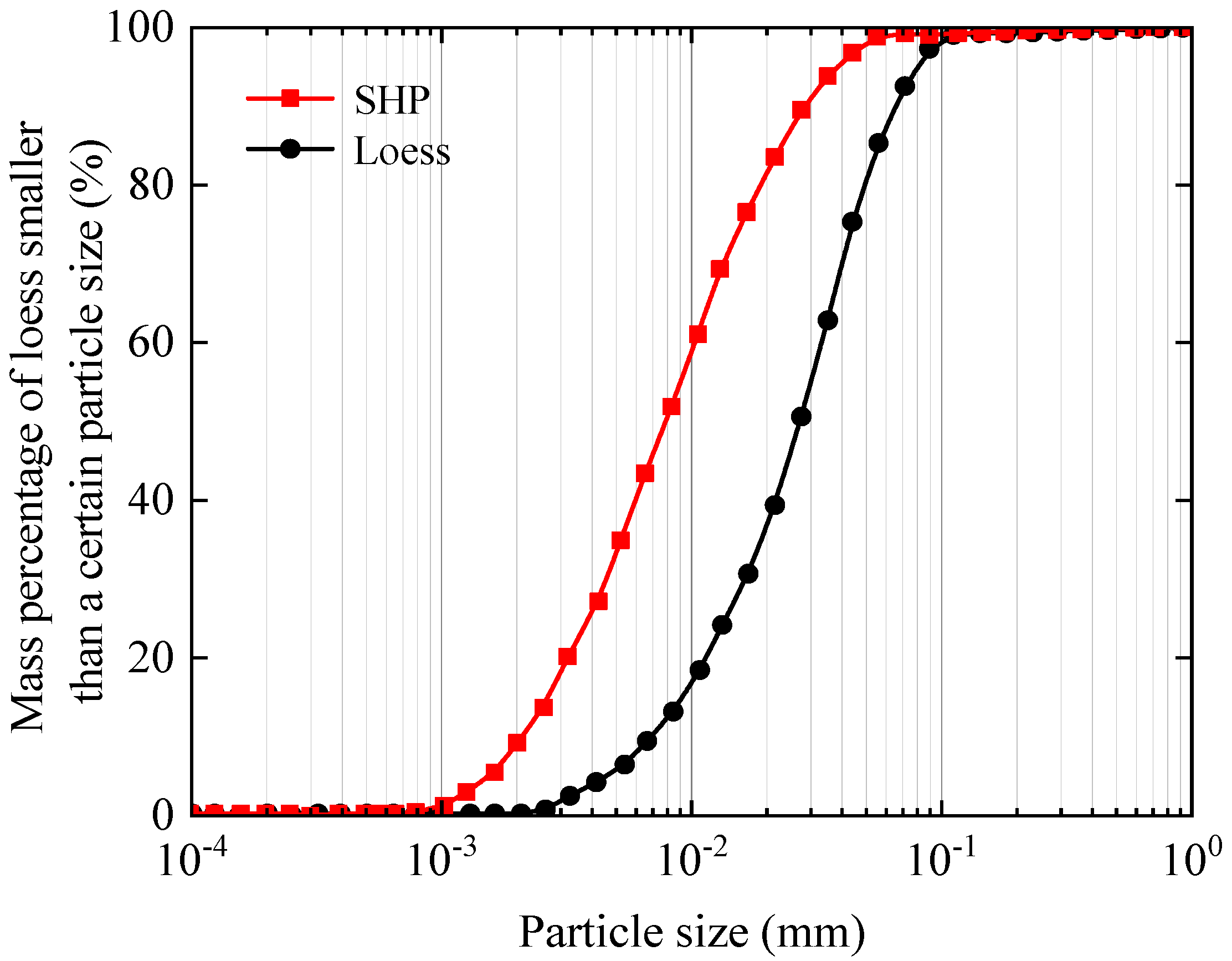


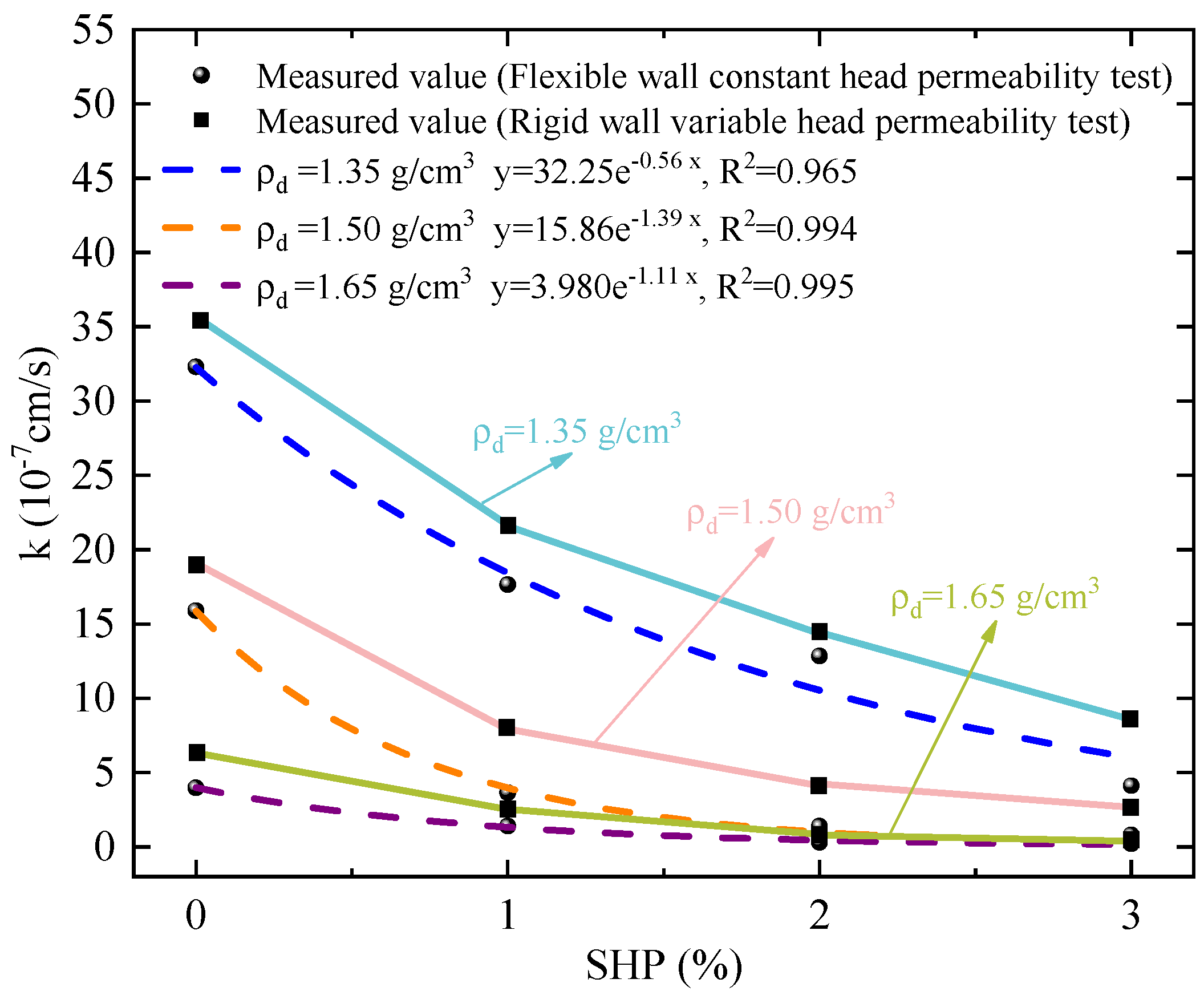
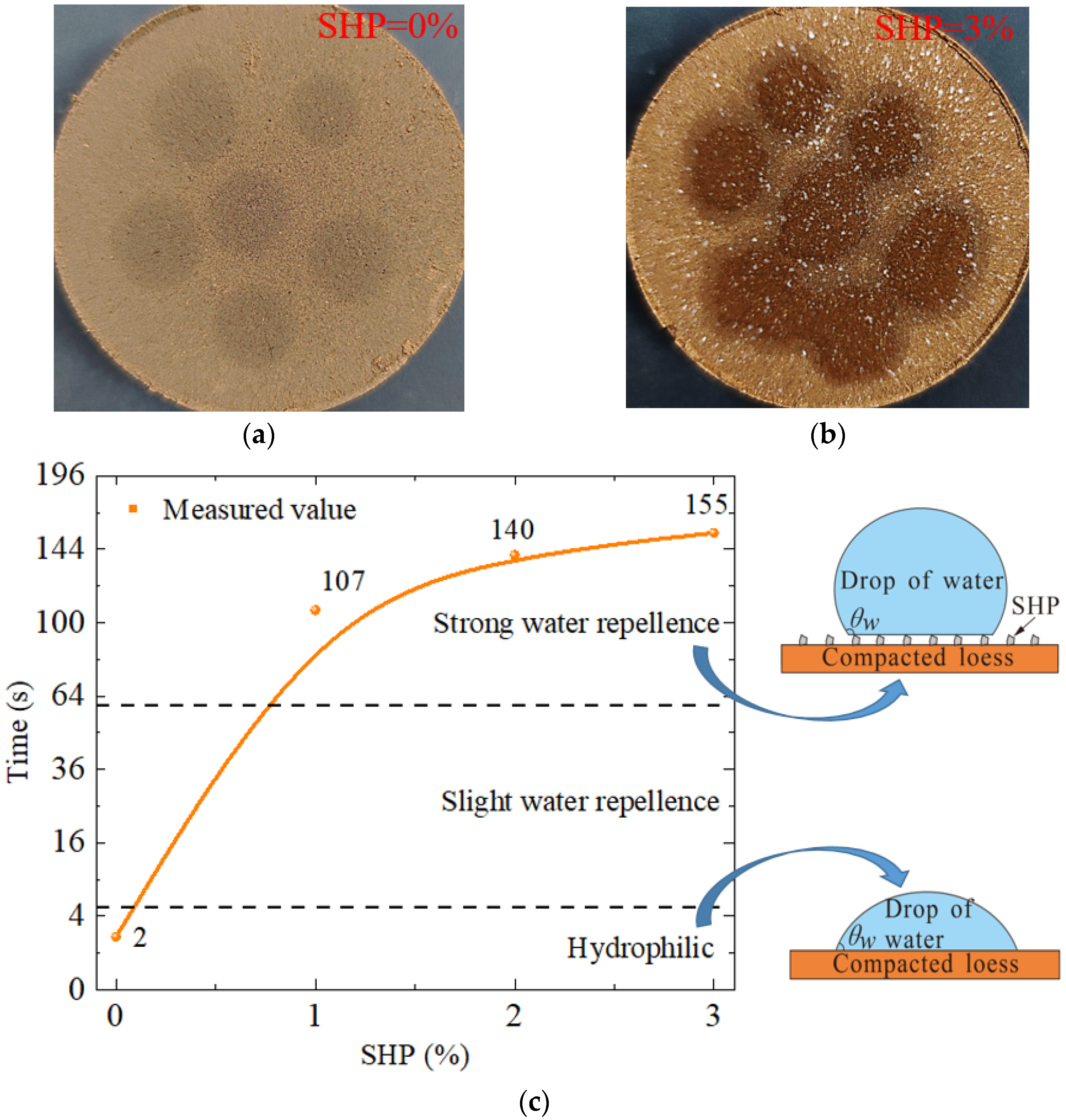
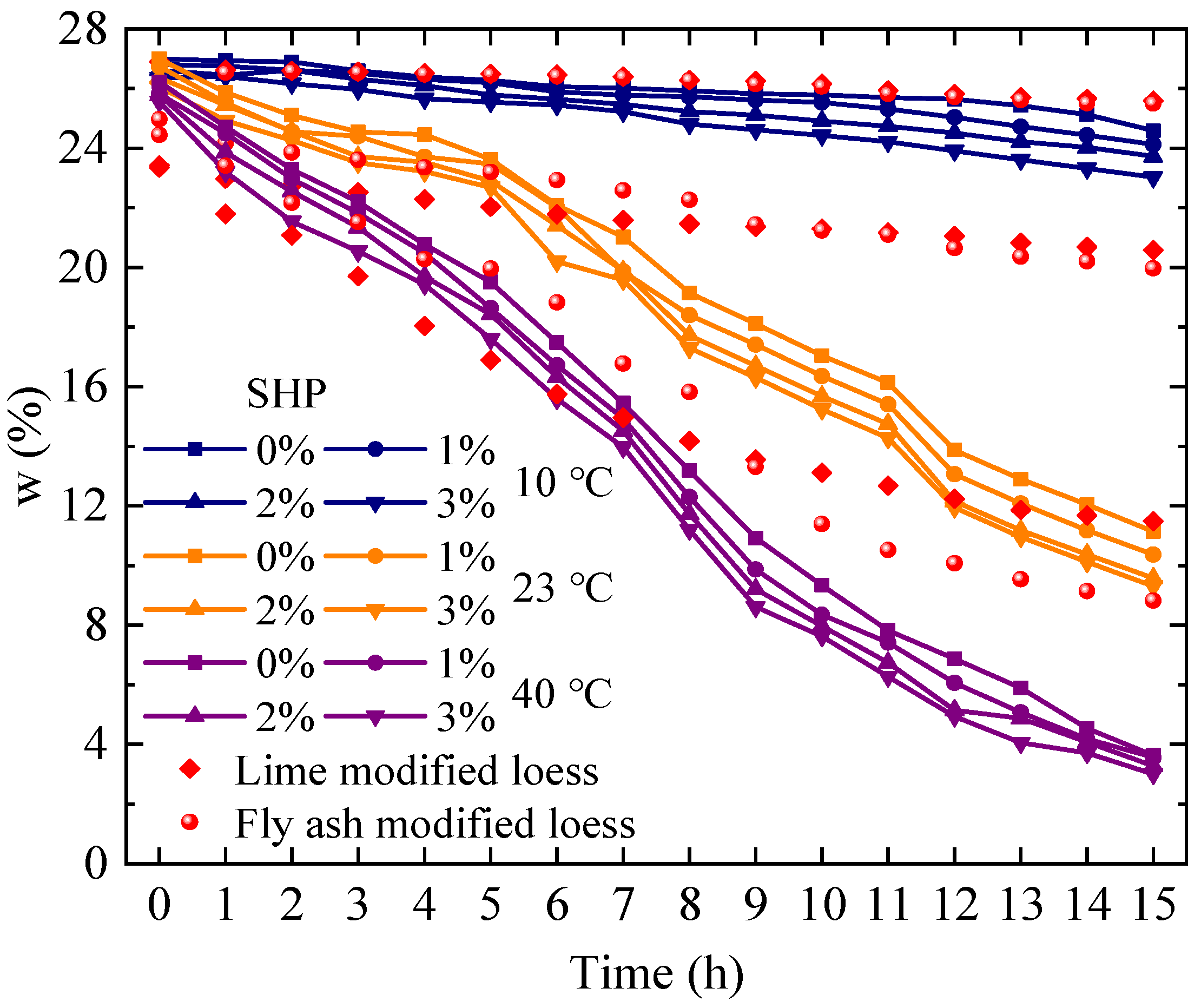
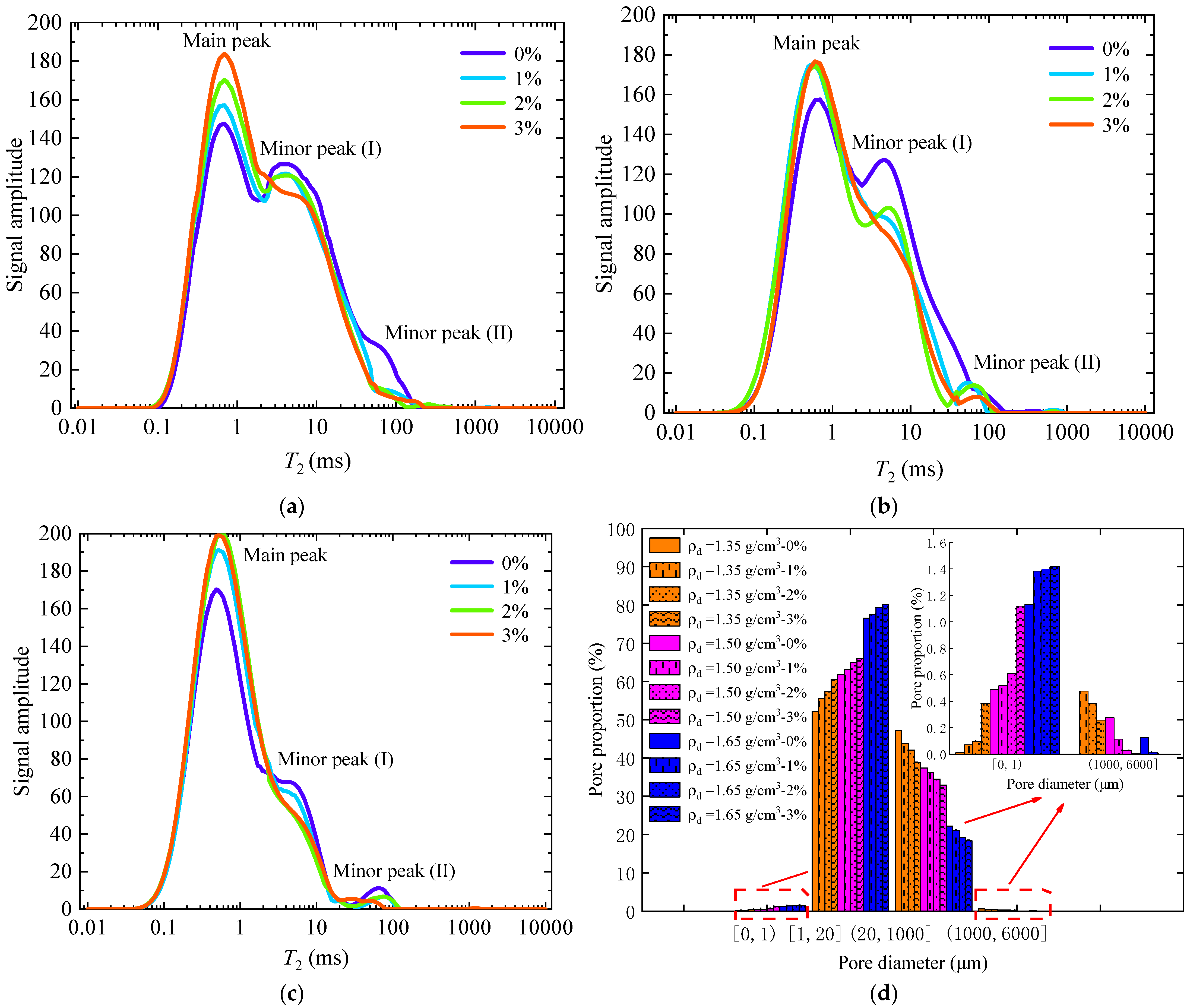




| Moisture Content of Specimens (%) | Specific Gravity | Optimum Moisture Content (%) | Max. Dry Density (g/cm3) | Liquid Limit (%) | Plasticity Index |
|---|---|---|---|---|---|
| 16.5 | 2.7 | 16.9 | 1.71 | 34 | 14.5 |
| Time (s) | Water Repellence Grade |
|---|---|
| <5 | Hydrophilic |
| 5–60 | Slight water repellence |
| 60–600 | Strong water repellence |
| 600–3600 | Severe water repellence |
| >3600 | Super water repellence |
| Dry Density (g/cm3) | Mixing Amount (%) | Flexible Wall Penetration (%) | Rigid Wall Penetration (%) |
|---|---|---|---|
| 1.35 | 0 | / | / |
| 1 | 45 | 43 | |
| 2 | 60 | 56 | |
| 3 | 87 | 85 | |
| 1.50 | 0 | / | / |
| 1 | 77 | 69 | |
| 2 | 91 | 88 | |
| 3 | 95 | 92 | |
| 1.65 | 0 | / | / |
| 1 | 65 | 59 | |
| 2 | 93 | 89 | |
| 3 | 95 | 93 |
| Atmospheric Temperature (°C) | Mixing Amount (%) | Fly Ash | Lime | |||
|---|---|---|---|---|---|---|
| 0 | 1 | 2 | 3 | |||
| 10 | −0.14 | −0.17 | −0.19 | −0.23 | −0.09 | −0.08 |
| 23 | −1.11 | −1.15 | −1.19 | −1.19 | −0.32 | −0.17 |
| 40 | −1.61 | −1.62 | −1.62 | −1.60 | −1.17 | −0.79 |
| Dry Density (g/cm3) | Mixing Amount (%) | Pore Proportion (%) | |||
|---|---|---|---|---|---|
| Small Pore [0, 1) | Medium Pore [1, 20] | Large Pore (20, 1000] | Extra-Large Pore (1000, 6000] | ||
| 1.35 | 0 | 0.01 | 52.15 | 47.13 | 0.59 |
| 1 | 0.07 | 55.54 | 43.80 | 0.48 | |
| 2 | 0.10 | 60.36 | 39.07 | 0.38 | |
| 3 | 0.38 | 65.47 | 33.89 | 0.25 | |
| 1.50 | 0 | 0.49 | 61.38 | 37.39 | 0.28 |
| 1 | 0.52 | 63.13 | 36.22 | 0.12 | |
| 2 | 0.61 | 64.90 | 34.46 | 0.03 | |
| 3 | 1.12 | 65.99 | 32.79 | 0.005 | |
| 1.65 | 0 | 1.13 | 76.52 | 22.19 | 0.12 |
| 1 | 1.38 | 77.51 | 21.07 | 0.02 | |
| 2 | 1.39 | 79.25 | 19.26 | 0.001 | |
| 3 | 1.42 | 80.18 | 18.38 | 0.0005 | |
| Dry Density (g/cm3) | Mixing Amount (%) | Pore Proportion (%) | Average Pore Length (μm) | Average Pore Width (μm) |
|---|---|---|---|---|
| 1.35 | 0 | 38.16 | 22.14 | 12.57 |
| 1 | 37.54 | 21.54 | 11.63 | |
| 2 | 37.18 | 20.68 | 10.85 | |
| 3 | 36.82 | 20.21 | 10.12 | |
| 1.50 | 0 | 35.39 | 21.15 | 10.88 |
| 1 | 34.67 | 20.67 | 9.97 | |
| 2 | 33.25 | 19.48 | 9.16 | |
| 3 | 33.87 | 18.46 | 8.87 | |
| 1.65 | 0 | 31.27 | 20.45 | 10.71 |
| 1 | 30.75 | 18.94 | 9.52 | |
| 2 | 30.49 | 16.62 | 8.35 | |
| 3 | 30.18 | 16.31 | 8.11 |
Disclaimer/Publisher’s Note: The statements, opinions and data contained in all publications are solely those of the individual author(s) and contributor(s) and not of MDPI and/or the editor(s). MDPI and/or the editor(s) disclaim responsibility for any injury to people or property resulting from any ideas, methods, instructions or products referred to in the content. |
© 2023 by the authors. Licensee MDPI, Basel, Switzerland. This article is an open access article distributed under the terms and conditions of the Creative Commons Attribution (CC BY) license (https://creativecommons.org/licenses/by/4.0/).
Share and Cite
Duan, X.; Xiao, D.; Zou, Y.; Dong, Q.; Ye, W.; Tang, L. Permeability Characteristics and Mechanism of Silicone-Hydrophobic-Powder-Modified Compacted Loess. Sustainability 2023, 15, 6606. https://doi.org/10.3390/su15086606
Duan X, Xiao D, Zou Y, Dong Q, Ye W, Tang L. Permeability Characteristics and Mechanism of Silicone-Hydrophobic-Powder-Modified Compacted Loess. Sustainability. 2023; 15(8):6606. https://doi.org/10.3390/su15086606
Chicago/Turabian StyleDuan, Xu, Di Xiao, Yu Zou, Qi Dong, Wanjun Ye, and Liyun Tang. 2023. "Permeability Characteristics and Mechanism of Silicone-Hydrophobic-Powder-Modified Compacted Loess" Sustainability 15, no. 8: 6606. https://doi.org/10.3390/su15086606




